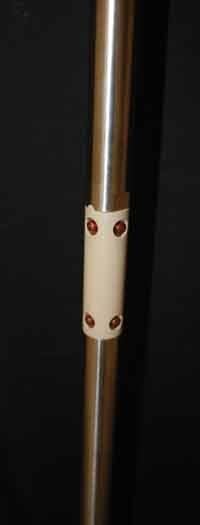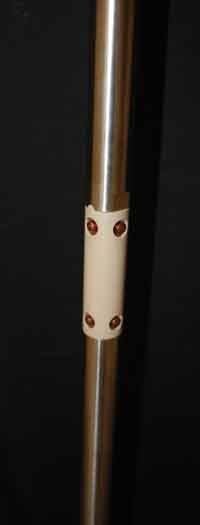Tool locates leaks, monitors downhole flow
Here's the Leakator—for which patents are pending—a tool that locates leaks and monitors downhole flow.
It promises to help improve efficiency and reduce operating costs by monitoring well integrity.
Its run-it-yourself capability means an existing on-site crew can operate the 25 mm diameter tool without the need for further staff. It is easy to maintain. No moving parts mean that only the o-rings and detachable batteries need to be replaced during servicing. And as a result of its small AA batteries, operators do not need to comply with dangerous goods legislation during transportation. This means operators can commit less time and staff to the job, the firm points out.
This modular memory instrument uses multiple sensor arrays, with synchronized data from the sensors merged and plotted against depth to highlight local variations in the well. This provides an indication of leaks. Optional sensor modules enable additional data to be monitored, including differential temperature, flow, and flow direction. The sensors are physically distributed and have a balanced output, allowing sensitivity to small local anomalies of temperature and flow. A surface readout capability is also possible.
As a result of the modular assembly, operators can customize the setup to fit the specific requirements of each individual job, determined by the various well conditions. And the Leakator's 25 mm diameter allows it to access all zones, the firn notes.
Source: Omega Well Monitoring, Reservoir Group Div., Unit 44-46 Howe Moss Ave., Kirkhill Industrial Estate, Dyce Aberdeen, AB21 0GP, UK.
Manufacturing intelligence software enhanced
A new version of Wonderware Intelligence software features predefined enterprise manufacturing intelligence content for the company's Wonderware MES/Performance, Wonderware InBatch, ArchestrA System Platform and SimSci-Esscor ROMeo 6.0 software solutions.
It offers improved metrics calculation capabilities with data-source-specific aggregation and multiple source calculations, automatic data source generation in the analytics client for use in chart displays, and a new OSI PI Server native adapter for faster access to OSI PI data.
Wonderware Intelligence software provides the ability to connect, collect, aggregate, and contextualize metrics in near real time across multiple sources. Users can easily access this high-value information themselves, providing self-service analytics, reports, and dashboards. Business unit operations and management-level plant and line performance can be compared with unified operational KPIs to leverage the best practices of high-performing plants and to identify unused potential in production capacity, or to improve operational decision-making.
Source: Invensys Operations Management, 26561 Ranch Parkway South, Lake Forest, CA 92630.
Steam trap series updated
The redesigned 3 in. and 4 in. FT450 float and thermostatic steam trap series has been improved with a new fabricated mechanism suited for where high pressure and high process flows are required.
The mechanical ball float trap has a body and cover made of cast carbon steel, thus increasing the trap's longevity and allowing maximum system efficiency. The series piping connections are horizontal in-line, and the body incorporates mounting legs with drill pads. The trap features a balanced pressure thermostatic air vent available for maximum temperatures of 572° F.
All internals are stainless steel and coated with UCT EXO nickel-boron to give long lasting durability. The head and seat are made of hardened stainless steel and with the coating prevents sticking and resists buildup of precipitants that can cause leakage. This trap series has an infinite turndown ratio over a range of flow and can operate from zero psig up to 450 psig steam pressures. The standard offering is available with National Pipe Thread, socket weld, and flanged connection.
Source: Spirax Sarco Inc., 1150 Northpoint Blvd., Blythewood, SC 29016.
New method speeds up 'creep' evaluation
A new method evaluates the slow deformation of materials under small stresses ("creep") via the use of instrumented indentation.
Available exclusively on this firm's Nano Indenter G200 platform, the new technique is simpler, faster, and easier than uniaxial creep testing, the firm says. It can be used to map the spatial distribution of creep capacity in complex materials and is insensitive to thermal drift.
The test method allows researchers to measure strain-rate sensitivity, the most important quantification of creep. It overcomes problems associated with long testing times by imposing small strain rates only when the applied force is large. Values acquired on standard references with the new technique are in agreement with values obtained by others on similar materials utilizing instrumented indentation and uniaxial creep testing. The easy-to-use method is implemented in the NanoSuite software package for the G200.
The G200 enables measurement of Young's modulus and hardness in compliance with ISO 14577, as well as measurement of deformation over six orders of magnitude—from nanometers to millimeters.
Source: Agilent Technologies Inc., 5301 Stevens Creek Blvd., Santa Clara, CA 95051.
More Oil & Gas Journal Current Issue Articles
More Oil & Gas Journal Archives Issue Articles
View Oil and Gas Articles on PennEnergy.com



